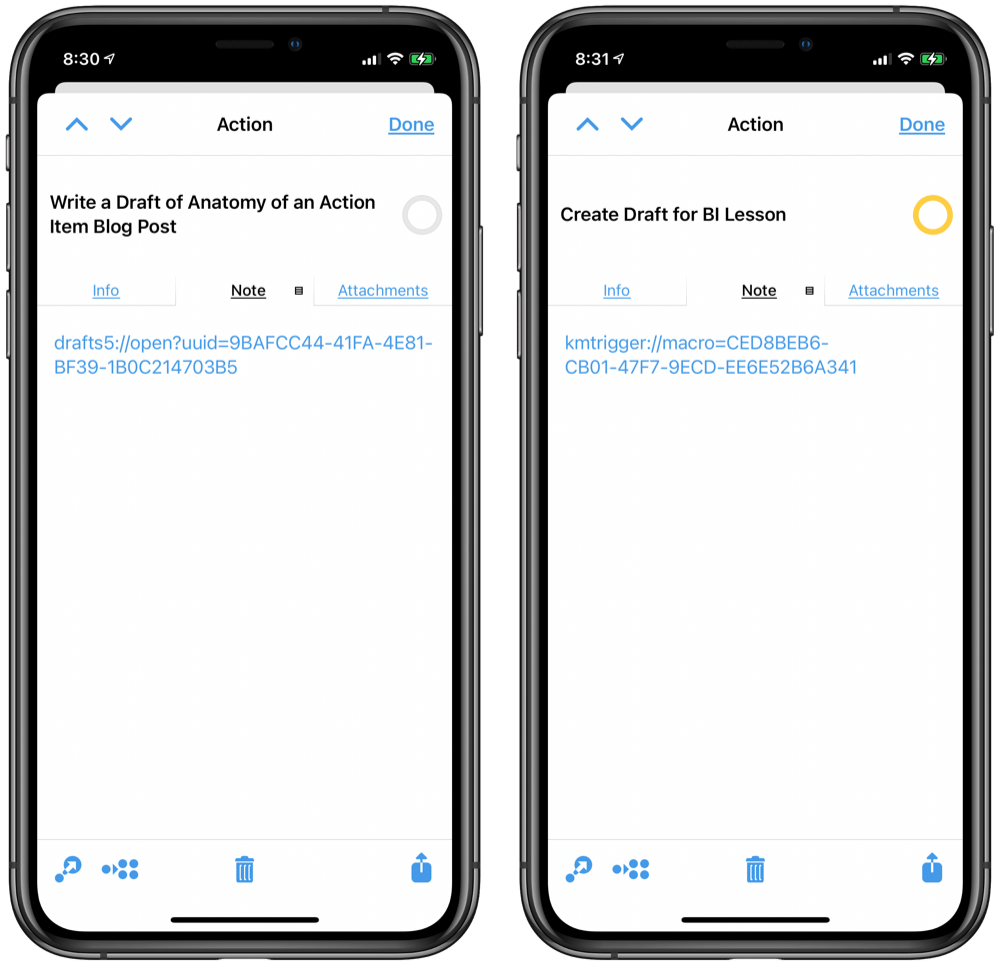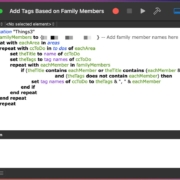Anatomy of an Action Item
I have written before about the hierarchy of tasks (i.e., action items) in OmniFocus. In this post, I will zoom in on the base unit of productivity, an action item, and identify the characteristics every action item should have.
I like using OmniFocus and calling tasks “action items.” Regardless of the program you use, and whatever you call the things you need to do, you should think about how they are composed. As of March 2021, I think these are the essential parts of an action item. When I clear to neutral every day, I make sure each action item that goes into my system has been reviewed for each of the following characteristics.
Relevant Dates
In my mind, there are two relevant dates that an action item can have; the start date and the due date. In my system, many action items only have one or the other, and even more have neither. But every action item that comes into my system gets reviewed for these relevant dates.
Defer Dates
More often than not, the start date (known by OmniFocus, and thus me, as a defer date) is the most common relevant date for me. Most of what is in the OmniFocus database are action items that I can’t work on yet, buying my wife a Mother’s Day gift, downloading a PDF of our mortgage statement, or planning my next department meeting. They are all essential things that I don’t want to forget about, but they are action items that I don’t want to see on my to-do list yet. If your task management solution supports start/defer dates, I encourage you to use them. They are quite freeing! Just make sure your defer date gives you plenty of time to complete the action item successfully, e.g., the Mother’s Day gift action item has a defer date of two weeks before Mother’s Day.
Due Dates
The classic date for action items is due dates or deadlines. I strongly encourage you to use due dates like a precious resource that is hard to replace. I developed this policy after the overuse of due dates in my system numbed me to their meaning.
When due dates lost their significance, several essential projects fell through the cracks in both my personal and professional life. It took quite a while to rebuild the trust of those I let down. Make sure the due dates you assign are real limits, and if I were you, move the due date forward one day.

Verb
This is a small language challenge to make sure your action item is actionable. Be sure that every action item in your system has a verb in it. “Dinner” is a bad action item. Am I planning dinner? Cooking it? Ordering it? Picking it up? More often than not, you will realize that it’s several of the above, and you have a project on your hands.
In no time, you will be thinking in verbs, and this will become unconscious. You will capture action items with the verbs in them already. Until then, review the action items in your system, make sure they have verbs in them and be purposeful about including verbs in your capture process.
Discrete
No need to buy a trench coat and get all sneaky here; I mean discrete (separate), not discreet (secret). Your action item should be something that has a clear beginning and end. I would also encourage you to scale this task so that it can be completed in one work session.
Feel free to define the length of your work session here. I know people who think about tasks in Pomodoros, so for them, they would break up projects into action items that fit into 25-minute chunks. During the school year, I often think in planning periods. Whatever unit of time fits your workflow is perfectly fine.
Use that unit to measure your action items. If you can’t complete your action item in one of your time units, I bet there is more than one action item there. Think about how you can break up that larger action item into smaller ones. This might seem like you are giving yourself more to do; I would argue that you are not. Instead, you are better defining your action items and thus giving yourself a better chance of success.
Notes
Almost all of my action items have some type of extra information that I need in order to complete them successfully. Scheduling a dentist appointment? What’s their phone number? Got to pay the mortgage? What’s the URL to the login page? Cleaning the coffee maker? What’s the ratio of white vinegar to water? You get the idea.
All of those are actual action items from my OmniFocus database. Each one has the relevant information stored as text in the notes field. But I also have plenty of action items in OmniFocus that have more exciting options. Because every device that I have OmniFocus on also has Drafts, I use the URL links in Drafts to link from an action item in OmniFocus to the draft I am working on. Writing this blog post is an action item in OmniFocus, and in the notes field, there is a link to this draft.

There are other action items in OmniFocus that have Keyboard Maestro URL triggers. “Create Draft for BI Lesson” is an action item that has a URL in the notes field which triggers Drafts to create a new draft from a template:
A Notes field is in pretty much every task manager and is often overlooked; I encourage you to rectify that error.
Yours
Finally, make sure the action item is actually something you need to do. There is plenty of wisdom in deleting action items that are no longer relevant or no longer need to be done, but that’s not the advice I am giving here (I am assuming that you have already made that choice). Here I am suggesting that you check to make sure your action item is something you can do, not something some has to do for you.
Recently I had to collect dues for my school’s chapter of the Science National Honor Society. We used an online payment portal, and one of my members paid twice; I needed to refund them, but I did not have the power to do that. Instead of “Refund STUDENT NAME for SNHS Dues Overpayment,” which is something I could not do, my action item was “Email POWERFUL PERSON About Refunding STUDENT NAME’s SNHS Dues Overpayment.”
Conclusion
There are plenty of cool features of OmniFocus that I use in addition to the essential anatomy I outlined above. I think anyone can apply the above list to any program. I hope giving you insight into my process helps you either build or reflect on yours. If there is something I am missing, please let me know in the comments below!












Just a bit to pick: a defer date is not a start date. Start date implies you will actually be starting on that date. Defer means that’s when the task becomes available to work on. You might start it, you might not but it’s in the lists at that point.
Certainly a fair point! I probably conflate the two when I shouldn’t, but they are functionally the same for me as my goal is to finish the action item on the defer date. However, nothing terrible happens if I don’t.
Thank you for your feedback, it has caused me to think more on the topic, and I will continue to do so!
Sorry Mike I left a comment before but found this hilarious. I left my comment above almost exactly two years ago. About 10 days ago I came across this page again having completely forgotten about it and having found it (again apparently) via some other website then amazed to see I left a comment almost two years ago. Not sure what it is about Sept. and this article for me! .
So reading this again two years later I’m curious about your usage of start/due now because if I remember correctly you’re now using Things vs OmniFocus and switched about a year after this post was published. I’ve always found only using a due date (I also switched from OF to Things about 5 years ago) a bit of a mess because then it’s ALWAYS in your Today list. If I set a due date I usually don’t want to see it until some point in the future when I can realistically start it so I set a start date as well.
Talk about evergreen content! I’m glad you found the post interesting enough to comment over the years.
You are correct that I switched from OmniFocus to Things a little less than two years ago now. Even with the tool change, my thoughts in this post are still a good description of how I process action items today.
Due dates (i.e., Deadlines in Things parlance) are precious commodities that I use only when there are real consequences if I miss them. However, I don’t have the same issue you are describing with Deadline items showing up in your Today view before the Deadline date. I have 17 items in Things with Deadlines assigned, but only one of them (a project) is showing up in my Today view. That project is due in 4 days, but there are two action items in that project that are on my Today list because of their When date. Those action items are “bringing” this future Deadline to the Today view.
Defer dates (i.e., When) are the primary way I build my Today list in Things. Many are repeating tasks/chores that show up in my Chores project. Some are part of a project template. The trick is making sure I use my Weekly Review and Clear to Neutral habits to audit my Anytime list and ensure high-impact work gets done. Otherwise, I just stay in maintenance mode.
That being said, Defer/When dates are things I don’t mind pushing to a future date or canceling altogether, so much so that I have dedicated buttons on my Stream Deck to do just that.